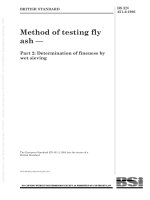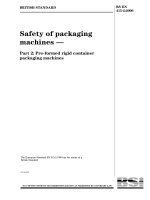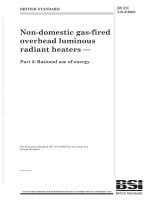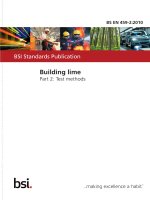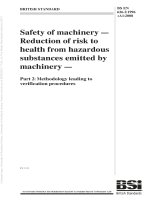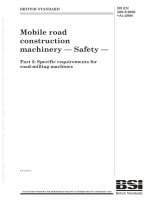Bsi bs en 45502 2 3 2010
Bạn đang xem bản rút gọn của tài liệu. Xem và tải ngay bản đầy đủ của tài liệu tại đây (948.72 KB, 48 trang )
BRITISH STANDARD
BS EN
45502-2-3:2010
Active implantable
medical devices
Part 2-3: Particular requirements
for cochlear and auditory brainstem
implant systems
ICS 11.040.40
--`,,```,,,,````-`-`,,`,,`,`,,`---
NO COPYING WITHOUT BSI PERMISSION EXCEPT AS PERMITTED BY COPYRIGHT LAW
Copyright British Standards Institution
Provided by IHS under license with BSI - Uncontrolled Copy
No reproduction or networking permitted without license from IHS
Not for Resale
BS EN 45502-2-3:2010
National foreword
This British Standard is the UK implementation of EN 45502-2-3:2010.
The UK participation in its preparation was entrusted to Technical
Committee CH/150/6, Active Surgical Implants.
A list of organizations represented on this committee can be obtained on
request to its secretary.
This publication does not purport to include all the necessary provisions
of a contract. Users are responsible for its correct application.
Compliance with a British Standard cannot confer immunity
from legal obligations.
This British Standard
was published under the
authority of the Standards
Policy and Strategy
Committee on 31 March
2010
Amendments/corrigenda issued since publication
Date
Comments
© BSI 2010
ISBN 978 0 580 70990 6
--`,,```,,,,````-`-`,,`,,`,`,,`---
Copyright British Standards Institution
Provided by IHS under license with BSI - Uncontrolled Copy
No reproduction or networking permitted without license from IHS
Not for Resale
BS EN 45502-2-3:2010
EN 45502-2-3
EUROPEAN STANDARD
NORME EUROPÉENNE
EUROPÄISCHE NORM
March 2010
ICS 11.040.40
English version
Active implantable medical devices - Part 2-3: Particular
requirements for cochlear and auditory brainstem implant
systems
Aktive implantierbare Medizingeräte - Teil 2-3: Besondere
Festlegungen für Cochlea-Implantatsysteme und
auditorische Hirnstammimplantatsysteme
Dispositifs médicaux implantables actifs - Partie 2-3:
Exigences particulières pour les systèmes d'implant
cochléaire et les systèmes d'implant auditif du tronc
cérébral
This European Standard was approved by CEN on 1 February 2010.
CEN and CENELEC members are bound to comply with the CEN/CENELEC Internal Regulations which stipulate the conditions for giving
this European Standard the status of a national standard without any alteration. Up-to-date lists and bibliographical references concerning
such national standards may be obtained on application to the CEN Management Centre or to any CEN and CENELEC member.
This European Standard exists in three official versions (English, French, German). A version in any other language made by translation
under the responsibility of a CEN and CENELEC member into its own language and notified to the CEN Management Centre has the same
status as the official versions.
CEN and CENELEC members are the national standards bodies and national electrotechnical committees of Austria, Belgium, Bulgaria,
Croatia, Cyprus, Czech Republic, Denmark, Estonia, Finland, France, Germany, Greece, Hungary, Iceland, Ireland, Italy, Latvia, Lithuania,
Luxembourg, Malta, Netherlands, Norway, Poland, Portugal, Romania, Slovakia, Slovenia, Spain, Sweden, Switzerland and United
Kingdom.
CEN Management Centre:
Avenue Marnix 17, B-1000 Brussels
CENELEC Central Secretariat:
Avenue Marnix 17, B-1000 Brussels
© 2010 CEN/CENELEC All rights of exploitation in any form and by any means reserved
worldwide for CEN national Members and for CENELEC
Members.
--`,,```,,,,````-`-`,,`,,`,`,,`---
Copyright British Standards Institution
Provided by IHS under license with BSI - Uncontrolled Copy
No reproduction or networking permitted without license from IHS
Not for Resale
Ref. No. EN 45502-2-3:2010 E
BS EN 45502-2-3:2010
EN 45502-2-3:2010
–2–
Foreword
This European Standard was prepared by the CEN/CENELEC Joint Working Group AIMD, Active
Implantable Medical Devices. Members of the Joint Working Group were nominated by one of the
members of either CEN or CENELEC. The lead has been given to CENELEC.
The text of the draft was submitted to a second formal vote and was approved by CEN and CENELEC as
EN 45502-2-3 on 2010-02-01.
Attention is drawn to the possibility that some of the elements of this document may be the subject of
patent rights. CEN and CENELEC shall not be held responsible for identifying any or all such patent
rights.
The following dates were fixed:
–
–
latest date by which the EN has to be implemented
at national level by publication of an identical
national standard or by endorsement
latest date by which the national standards conflicting
with the EN have to be withdrawn
(dop)
2011-02-01
(dow)
2013-02-01
The requirements of this particular standard supplement or modify those of the General Standard
EN 45502-1:1997, Active implantable medical devices – Part 1: General requirements for safety, marking
and information to be provided by the manufacturer.
This European Standard has been prepared under a mandate given to CEN and CENELEC by the
European Commission and the European Free Trade Association and covers essential requirements of
EC Directive 90/385/EEC. See Annexes AA and BB.
--`,,```,,,,````-`-`,,`,,`,`,,`---
Although both this European Standard and the Directive deal with the same range of products, the
structure and purpose of the two documents are different. Annex AA, BB, CC are rationales, providing
some further explanation of particular subclauses of this European Standard. All three annexes are
informative.
__________
Copyright British Standards Institution
Provided by IHS under license with BSI - Uncontrolled Copy
No reproduction or networking permitted without license from IHS
Not for Resale
BS EN 45502-2-3:2010
–3–
EN 45502-2-3:2010
Contents
Introduction ...............................................................................................................................................5
1
Scope .................................................................................................................................................6
2
Normative references .........................................................................................................................6
3
Definitions ...........................................................................................................................................7
4
Symbols and abbreviations (optional) ................................................................................................9
5
General requirements for non-implantable parts................................................................................9
6
Inspection and measurement .............................................................................................................9
7
General arrangement of the packaging ............................................................................................10
8
General markings for active implantable medical devices ...............................................................10
9
Markings on the SALES PACKAGING ...................................................................................................10
10 Construction of the SALES PACKAGING ...............................................................................................11
11 Markings on the sterile pack.............................................................................................................11
12 Construction of the non-reusable pack ............................................................................................12
13 Markings on the active implantable medical device .........................................................................12
14 Protection from unintentional biological effects being caused by the active implantable medical
device ...............................................................................................................................................12
15 Protection from harm to the patient or user caused by external physical features of the active
implantable medical device ..............................................................................................................13
16 Protection from harm to the patient caused by electricity ................................................................13
17 Protection from harm to the patient caused by heat ........................................................................13
18 Protection from ionizing radiation released or emitted from the active implantable medical device 14
19 Protection from unintended effects caused by the device ...............................................................14
20 Protection of the device from damage caused by external defibrillators .........................................15
--`,,```,,,,````-`-`,,`,,`,`,,`---
21 Protection of the device from changes caused by high power electrical fields applied directly to
the patient .........................................................................................................................................15
22 Protection of the active implantable medical device from changes caused by miscellaneous
medical treatments ...........................................................................................................................16
23 Protection of the active implantable medical device from mechanical forces ..................................18
24 Protection of the active implantable medical device from damage caused by electrostatic
discharge ..........................................................................................................................................23
25 Protection of the active implantable medical device from damage caused by atmospheric
pressure changes .............................................................................................................................24
26 Protection of the active implantable medical device from damage caused by temperature
changes ............................................................................................................................................24
27 Protection of the active implantable medical device from electromagnetic non-ionising radiation ..24
28 Accompanying documentation .........................................................................................................27
Annex AA (informative) Notes on EN 45502-2-3 ..................................................................................30
Annex BB (informative) Notes on theoretical modelling to demonstrate compliance to Clause 27 ......38
Annex CC (informative) Notes on EMI measurements to demonstrate compliance to Clause 27 .......40
Bibliography ............................................................................................................................................44
Copyright British Standards Institution
Provided by IHS under license with BSI - Uncontrolled Copy
No reproduction or networking permitted without license from IHS
Not for Resale
BS EN 45502-2-3:2010
EN 45502-2-3:2010
–4–
Figures
Figure 101 – Measurement of output signal amplitude and load impedance ....................................... 10
Figure 102 – Test set-up for proof of protection from high frequency currents caused by surgical
equipment .............................................................................................................................................. 15
Figure 103 – Test set-up for proof of protection from harmful output during MRI scanning ................. 17
Figure 104 – Stimulator drop test .......................................................................................................... 20
Figure 105 – Flex test fixture ................................................................................................................. 21
Figure 106 – Interference signal at 16 Hz and 50 Hz ............................................................................ 26
Figure 107 – Interference signal at frequencies above 1 kHz ............................................................... 26
Figure CC.101 – Head simulator for EMI measurements ..................................................................... 41
Tables
Table 101 – Peak magnetic field strength HP ........................................................................................ 25
Table 102 – Peak electric field strength EP ........................................................................................... 26
Table CC.101 – Peak net dipole power ................................................................................................. 43
--`,,```,,,,````-`-`,,`,,`,`,,`---
Copyright British Standards Institution
Provided by IHS under license with BSI - Uncontrolled Copy
No reproduction or networking permitted without license from IHS
Not for Resale
BS EN 45502-2-3:2010
–5–
EN 45502-2-3:2010
Introduction
This European Standard specifies particular requirements for those ACTIVE IMPLANTABLE MEDICAL DEVICES
that are intended to treat hearing impairment via electrical stimulation (for EXAMPLE COCHLEAR IMPLANT
SYSTEMS or AUDITORY BRAINSTEM IMPLANT SYSTEMS), to provide basic assurance of safety for both patients
and users.
A COCHLEAR IMPLANT SYSTEM or AUDITORY BRAINSTEM IMPLANT SYSTEM is an ACTIVE IMPLANTABLE MEDICAL
DEVICE comprising implantable and NON-IMPLANTABLE PARTS (external parts). The power source may be
externally derived or from an internal battery. The IMPLANT SYSTEM is designed to restore hearing via
electrical stimulation of the auditory pathways. Externally or internally processed acoustic information is
converted to electrical stimulation signals which are delivered via one or more electrodes. The working
parameters of the device may be adjusted via a non-implantable accessory.
This European Standard is relevant to all parts of IMPLANT SYSTEMS, including accessories.
The requirements of this European Standard supplement or modify those of EN 45502–1:1997, Active
implantable medical devices – Part 1: General requirements for safety, marking and information to be
provided by the manufacturer, hereinafter referred to as Part 1. The requirements of this European
Standard take priority over those of Part 1.
Figures or tables that are additional to those of Part 1 are numbered starting from 101; additional annexes
are lettered AA, BB, etc.
--`,,```,,,,````-`-
Copyright British Standards Institution
Provided by IHS under license with BSI - Uncontrolled Copy
No reproduction or networking permitted without license from IHS
Not for Resale
BS EN 45502-2-3:2010
EN 45502-2-3:2010
1
–6–
Scope
This Part 2-3 of EN 45502 specifies requirements that are applicable to those ACTIVE IMPLANTABLE
that are intended to treat hearing impairment via electrical stimulation of the auditory
pathways. Devices which treat hearing impairment via means other than electrical stimulation are not
covered by this European Standard.
MEDICAL DEVICES
The tests that are specified in EN 45502 are type tests and are to be carried out on samples of a device
to show compliance.
This Part of EN 45502 is also applicable to NON-IMPLANTABLE PARTS and accessories of the devices (see
NOTE 1).
The electrical characteristics of the IMPLANTABLE PART shall be determined by either the appropriate
method detailed in this particular standard or by any other method demonstrated to have an accuracy
equal to, or better than, the method specified. In the case of dispute, the method detailed in this particular
standard shall apply.
NOTE 1 The device that is commonly referred to as an active implantable medical device can in fact be a single device, a
combination of devices, or a combination of a device or devices and one or more accessories. Not all of these parts are required to
be either partially or totally implantable, but there is a need to specify some requirements of NON-IMPLANTABLE PARTS and
accessories if they could affect the safety or performance of the implantable part.
NOTE 2 The terminology used in this European Standard is intended to be consistent with the terminology of Directive
90/385/EEC.
NOTE 3 In this European Standard, terms printed in small capital letters are used as defined in Clause 3. Where a defined term is
used as a qualifier in another term, it is not printed in small capital letters unless the concept thus qualified is also defined.
2
Normative references
This clause of Part 1 applies except as follows:
Additional references:
1)
2007
Medical devices - Application of risk management to medical devices
(ISO 14971:2007)
EN 1593
1999
Non-destructive testing - Leak testing - Bubble emission techniques
EN 13185
2001
Non-destructive testing - Leak testing – Tracer gas method
EN 45502-1
1997
Active implantable medical devices - Part 1: General requirements
for safety, marking and information to be provided by the
manufacturer
EN 55011
+ A2
2007
2007
Industrial, scientific and medical (ISM) radio-frequency equipment Electromagnetic disturbance characteristics - Limits and methods of
measurement (CISPR 11:2003, mod. + A1:2004, mod. + A2:2006)
EN ISO 14971
EN 60068-2-27
2)
1993
Basic environmental testing procedures - Part 2: Tests - Test Ea and
guidance: Shock (IEC 60068-2-27:1987)
EN 60068-2-31
3)
2008
Basic environmental testing procedures - Part 2: Tests - Test Ec:
Drop and topple, primarily for equipment-type specimens
(IEC 60068-2-31:1969 + A1:1982)
1)
2)
Superseded by EN ISO 14971:2009 “Medical devices - Application of risk management to medical devices” (ISO 14971:2007).
Will be superseded by EN 60068-2-27:2009 “Environmental testing - Part 2-27: Tests - Test Ea and guidance: Shock”
(IEC 60068-2-27:2008) at the dow of the latter, i.e. 2012-05-01.
--`,,```,,,,````-`-`,,`,,`,`,,`---
Copyright British Standards Institution
Provided by IHS under license with BSI - Uncontrolled Copy
No reproduction or networking permitted without license from IHS
Not for Resale
BS EN 45502-2-3:2010
–7–
EN 45502-2-3:2010
EN 60068-2-47
2005
Environmental testing - Part 2-47: Tests - Mounting of specimens for
vibration, impact and similar dynamic tests (IEC 60068-2-47:2005)
EN 60068-2-64
2008
Environmental testing - Part 2-64: Tests - Test Fh: Vibration,
broadband random and guidance (IEC 60068-2-64:2008)
EN 60068-2-75
1997
Environmental testing - Part 2-75: Tests - Test Eh: Hammer tests
(IEC 60068-2-75:1997)
EN 60118-6
1999
Hearing aids - Part 6: Characteristics of electrical input circuits for
hearing aids (IEC 60118-6:1999)
EN 60601-1
2006
Medical electrical equipment - Part 1: General requirements for basic
safety and essential performance (IEC 60601-1:2005)
EN 60601-1-2
2007
Medical electrical equipment - Part 1-2: General requirements for
basic safety and essential performance - Collateral standard:
Electromagnetic compatibility - Requirements and tests
(IEC 60601-1-2:2007, mod.)
4)
1993
Electromagnetic compatibility for industrial-process measurement
and control equipment - Part 2: Electrostatic discharge requirements
(IEC 60801-2:1991)
EN 60801-2
3
Definitions
This clause of Part 1 applies except as follows:
Additional definitions:
3.3.1
cochlear implant system
(CIS)
active implantable medical device, comprising implantable and NON-IMPLANTABLE PARTS, intended to treat
hearing impairment via electrical stimulation of the cochlea
--`,,```,,,,````-`-`,,`,,`,`,,`---
3.3.2
auditory brainstem implant system
(BIS)
ACTIVE IMPLANTABLE MEDICAL DEVICE, comprising implantable and NON-IMPLANTABLE PARTS, intended to
treat hearing impairment via electrical stimulation of the auditory brainstem
3.3.3
implant system
either COCHLEAR IMPLANT SYSTEM or AUDITORY BRAINSTEM IMPLANT SYSTEM
3.3.4
non-implantable part
external part of the IMPLANT SYSTEM
NOTE Examples would include but are not limited to: sound processor, microphone, coil or power source.
3.3.5
stimulator
implantable part of the IMPLANT SYSTEM containing electronic circuitry required to produce electrical
stimulation
3)
Will be superseded by EN 60068-2-31:2008 “Environmental testing - Part 2-31: Tests - Test Ec: Rough handling shocks,
primarily for equipment-type specimens” (IEC 60068-2-31:2008) at the dow of the latter, i.e. 2011-07-01.
4)
Superseded by EN 61000-4-2:1995, “Electromagnetic compatibility (EMC) - Part 4-2: Testing and measurement techniques Electrostatic discharge immunity test” (IEC 61000-4-2:1995).
Copyright British Standards Institution
Provided by IHS under license with BSI - Uncontrolled Copy
No reproduction or networking permitted without license from IHS
Not for Resale
BS EN 45502-2-3:2010
EN 45502-2-3:2010
–8–
3.3.6
body-worn
NON-IMPLANTABLE PART of the IMPLANT SYSTEM and worn on the body (e.g. belt or ear level)
3.5.1
electrode contact
electrically conducting part which is designed to form an interface with body tissue or body fluid
3.5.2
electrode array
DISTAL part of a LEAD containing more than one ELECTRODE CONTACT
3.5.3
reference electrode
electrically conducting part designed as return path for electrical stimulation current
3.5.4
distal
located away from the point of attachment to the STIMULATOR
3.5.5
proximal
located closest to the point of attachment to the STIMULATOR
3.9.1
model designation
name and/or a combination of letters and numbers used by a manufacturer to distinguish, by function or
type, one device from another
3.9.2
serial number
unique combination of letters and/or numbers, selected by the manufacturer, intended to distinguish a
device from other devices with the same MODEL DESIGNATION
3.20.1
output signal
electrical output, either pulsatile or analogue of an IMPLANT SYSTEM intended to stimulate the auditory
pathways
3.20.2
pulse
specified electrical OUTPUT SIGNAL (voltage or current) of a specified amplitude and duration
3.20.3
biphasic pulse
PULSE which has both negative and positive going phases
--`,,```,,,,````-`-`,,`,,`,`,,`---
3.22.1
use-before-date
date after which the manufacturer recommends that the IMPLANT SYSTEM should not be implanted
3.22.2
magnet
component producing an external magnetic flux
Copyright British Standards Institution
Provided by IHS under license with BSI - Uncontrolled Copy
No reproduction or networking permitted without license from IHS
Not for Resale
BS EN 45502-2-3:2010
–9–
4
EN 45502-2-3:2010
Symbols and abbreviations (optional)
NOTE There are no requirements specified in this Part of EN 45502. However this does not preclude the use of symbols defined in
other standards nor special symbols defined in the accompanying documentation.
5
General requirements for non-implantable parts
5.1
This subclause of part 1 applies.
5.2
Replacement
The IMPLANT SYSTEM shall meet the requirements of EN 60601-1-2:2007 for Group 1 equipment as
specified in EN 55011:2007.
Compliance shall be checked by review of the test results and documentation provided by the
manufacturer.
6
Inspection and measurement
If this standard refers to inspection of design analysis documentation provided by the manufacturer it shall
include an inspection of the risk management file as required by EN ISO 14971.
6.1 Measurement of output signal characteristics
The measurement shall be performed with the implantable part of the IMPLANT SYSTEM at a temperature of
(37 ± 2) °C. The IMPLANT SYSTEM shall be configured to use its maximum number of outputs and each
output shall be programmed to its maximum value (amplitude and pulse width). An input signal equivalent
to 70dB SPL shall be applied to the microphone. Where applicable the transcutaneous link shall operate
over a distance of (5 ± 1) mm. Where the IMPLANT SYSTEM provides alternative OUTPUT SIGNALS each shall
be measured and listed separately. To facilitate connection the test sample may be unfinished. The
accuracy of the amplitude measurement shall be better than ± 5 % taking all errors into consideration.
6.2 Measurement of the OUTPUT SIGNAL amplitude and pulse width
6.3 Impedance measurement accuracy
Where the IMPLANT SYSTEM allows an impedance measurement (either by telemetry or direct
measurement) the manufacturer shall specify the accuracy of the impedance measurement for a 10 kΩ
load resistor. The measurement conditions shall be chosen to reflect normal clinical practice. The
measurement shall be repeated on every output (see Figure 101). The accuracy of the impedance
measurement shall be expressed as a percentage.
Copyright British Standards Institution
Provided by IHS under license with BSI - Uncontrolled Copy
No reproduction or networking permitted without license from IHS
Not for Resale
--`,,```,,,,````-`-`,,`,,`,`,,`---
A representative sample of the IMPLANT SYSTEM shall have each output connected to a 1 kΩ (± 1 %) load
resistor (see Figure 101) and configured per 6.1. An oscilloscope shall be adjusted to display the full
output at its maximum resolution. The measurement shall be made in the peak of the OUTPUT SIGNAL.
Each output shall be in turn connected to the oscilloscope and the amplitude and pulse width shall be
measured. The median of the amplitudes and pulse widths and their range shall be recorded and the
result shall be expressed in µA and µs.
BS EN 45502-2-3:2010
EN 45502-2-3:2010
– 10 –
NOTE Ground is connected to the external reference electrode, if available.
Figure 101 – Measurement of output signal amplitude and load impedance
General arrangement of the packaging
7.1
This subclause of Part 1 applies.
7.2
This subclause of Part 1 applies.
8
General markings for active implantable medical devices
8.1
This subclause of Part 1 applies.
8.2
This subclause of Part 1 applies.
9
Markings on the SALES PACKAGING
9.1
This subclause of Part 1 applies.
9.2
This subclause of Part 1 applies except as follows:
Replacement:
The SALES PACKAGING shall bear the name and address of the manufacturer, the address including at
least the city and country. The SALES PACKAGING shall bear the name and address of the authorized
representative, if the manufacturer does not have a registered place of business in the European
Community
Compliance is checked by inspection.
9.3
This subclause of Part 1 applies.
9.4
This subclause of Part 1 applies.
9.5
This subclause of Part 1 applies.
9.6
This subclause of Part 1 applies.
Copyright British Standards Institution
Provided by IHS under license with BSI - Uncontrolled Copy
No reproduction or networking permitted without license from IHS
Not for Resale
--`,,```,,,,````-`-`,,`,,`,`,,`---
7
BS EN 45502-2-3:2010
– 11 –
The SALES PACKAGING of
USE-BEFORE-DATE, as expressed
9.7
EN 45502-2-3:2010
implantable parts of an ACTIVE IMPLANTABLE MEDICAL DEVICE shall bear the
in 9.6.
Compliance shall be checked by inspection.
9.8
This subclause of Part 1 applies.
9.9
This subclause of Part 1 applies.
9.10
This subclause of Part 1 applies.
9.11
This subclause of Part 1 applies.
9.12
Additional subclause
Where an implant system is supplied in separate sub-assembly packaging, each individual sales
packaging shall bear a description of the contents of the packaging, the model designation or part number
and, if applicable the batch number or the serial number.
Compliance shall be checked by inspection.
10 Construction of the SALES PACKAGING
10.1
This subclause of Part 1 applies
10.2
This subclause of Part 1 applies.
10.3
This subclause of Part 1 applies.
Additional note:
NOTE Removable stickers, which provide supplementary information exceeding the information specified in Clause 9, need not to
be subjected to the test specified in 10.3.
10.4
This subclause of Part 1 applies.
11 Markings on the sterile pack
11.1
This subclause of Part 1 applies.
11.2
This subclause of Part 1 applies.
11.3
This subclause of Part 1 applies.
11.4
This subclause of Part 1 applies.
11.5
This subclause of Part 1 applies.
11.6
This subclause of Part 1 applies.
11.7
This subclause of Part 1 applies.
11.8
This subclause of Part 1 applies.
--`,,```,,,,````-`-`,,`,,`,`,,`---
Copyright British Standards Institution
Provided by IHS under license with BSI - Uncontrolled Copy
No reproduction or networking permitted without license from IHS
Not for Resale
BS EN 45502-2-3:2010
EN 45502-2-3:2010
11.9
– 12 –
This subclause of Part 1 applies.
NOTE This subclause can be fulfilled using an unambiguous symbol.
12 Construction of the non-reusable pack
12.1
This subclause of Part 1 applies except as follows:
Replacement:
The NON-REUSEABLE PACK shall comply with EN ISO 11607-1.
Compliance shall be checked by inspection and by review of records provided by the manufacturer.
12.2
This subclause of Part 1 applies.
12.3
This subclause of Part 1 applies.
13 Markings on the active implantable medical device
13.1
This subclause of Part 1 applies.
13.2
This subclause of Part 1 applies.
13.3
Replacement
Implantable parts of an IMPLANT SYSTEM shall be unequivocally identifiable (particularly with regard to the
model designation of the device), when necessary, without the need for a surgical intervention.
Compliance shall be confirmed by inspection of the procedure defined by the manufacturer in the
instructions for use (see 28.6).
13.4
This subclause of Part 1 applies.
14 Protection from unintentional biological effects being caused by the active
implantable medical device
14.1
This subclause of Part 1 applies.
14.2
Any implantable part of the ACTIVE IMPLANTABLE MEDICAL DEVICE, intended in normal use to be in
contact with body fluids, shall cause no unacceptable release of particulate matter when the device is
used as intended by the manufacturer.
The implantable part of the IMPLANT SYSTEM shall be removed aseptically from the NONThe implantable part shall be immersed in a bath of saline solution, approximately 9 g/l
and suitable for injection in a neutral glass container. The volume of the saline in millilitres (ml) shall be
2
5 ± 0,5 times the numerical value of the surface area of the implantable part expressed in cm . The
container shall be covered with a glass lid and maintained at (37 ± 2) °C for between 8 h and 18 h, the
bath being agitated throughout the period. A reference sample of similar volume shall be prepared from
the same batch of saline, maintained and agitated in a similar way to the specimen. A sample of liquid
from the specimen bath and from the reference bath shall be compared using apparatus suitable for
measurement of particle size, such as apparatus operating on the light blockage principle (see
method V.5.7.1 of the European Pharmacopoeia) or the electrical zone sensing principle (the Coulter
principle, see Appendix XIII of the British Pharmacopoeia).
Test:
REUSABLE PACK.
Compliance shall be confirmed if the excess average count of unintentional particles from the specimen
compared to the reference sample does not exceed 100 per ml greater than 5,0 µm and does not exceed
5 per ml greater than 25 µm.
--`,,```,,,,````-`-`,,`,,`,`,,`---
Copyright British Standards Institution
Provided by IHS under license with BSI - Uncontrolled Copy
No reproduction or networking permitted without license from IHS
Not for Resale
BS EN 45502-2-3:2010
– 13 –
14.3
EN 45502-2-3:2010
Replacement
This subclause of Part 1 applies with addition that EN ISO 10993 series shall be used.
14.4
This subclause of Part 1 applies.
15 Protection from harm to the patient or user caused by external physical features of
the active implantable medical device
15.1
This subclause of Part 1 applies.
15.2
Replacement
Implantable parts of an IMPLANT SYSTEM shall have no surface features, such as sharp corners or edges
that could cause excessive reaction or inflammation beyond that caused by the implanting procedure, or
rough surfaces which are not required for the correct functioning of the device.
Compliance shall be confirmed if records provided by the manufacturer establish that the safety of the
physical characteristics has been verified with appropriate methods.
16 Protection from harm to the patient caused by electricity
16.1 Replacement
Electrical audio inputs into NON-IMPLANTABLE PARTS of an IMPLANT SYSTEM shall comply with the
requirements for electrical safety of the hearing aid standard EN 60118-6:1999. Other electrical inputs or
outputs of NON-IMPLANTABLE PARTS of an IMPLANT SYSTEM that allow the NON-IMPLANTABLE PART to be
connected to supply mains or mains powered devices which do not meet the insulation requirements of
EN 60601-1 shall either contain or be provided with a separation device which complies with the
applicable clauses regarding insulation of EN 60601-1 (separation device as defined in EN 60601-1:2006,
16.5.).
NOTE A separation device is not required for battery powered devices when used stand-alone.
Compliance shall be checked as specified in EN 60601-1 (if applicable) and by review of the
documentation provided by the manufacturer.
16.2 Replacement
Except for its intended function, implantable parts of an IMPLANT SYSTEM shall be electrically neutral when
in contact with the body. No leakage current (direct current) of more than 0,1 µA shall be sustained in any
of the current pathways when the device is in use.
Compliance shall be confirmed by inspection of test procedures and results provided by the
manufacturer.
16.3
This subclause of Part 1 applies..
17 Protection from harm to the patient caused by heat
--`,,```,,,,````-`-`,,`,,`,`,,`---
17.1
This subclause of Part 1 applies.
17.2
(Vacant)
Copyright British Standards Institution
Provided by IHS under license with BSI - Uncontrolled Copy
No reproduction or networking permitted without license from IHS
Not for Resale
BS EN 45502-2-3:2010
EN 45502-2-3:2010
– 14 –
18 Protection from ionizing radiation released or emitted from the active implantable
medical device
18.1
This subclause of Part 1 applies.
18.2
This subclause of Part 1 applies.
18.3
This subclause of Part 1 applies.
19 Protection from unintended effects caused by the device
19.1
This subclause of Part 1 applies.
19.2
Replacement
If the implantable part of an IMPLANT SYSTEM contains within it a source of power, such as a battery, the
IMPLANT SYSTEM shall include an ‘indicator’ that gives advance notice of energy source depletion to the
clinician and user.
Compliance shall be confirmed by inspection of a design analysis provided by the manufacturer,
supported by the manufacturer’s calculations and data from test studies as appropriate.
19.3
This subclause of Part 1 applies.
19.4
This subclause of Part 1 applies except as follows:
Replacement of the assessment:
Side effects and benefits from the intended use of the device shall be identified either by reference to
current medical practice and demonstrated by analogy, or by reference to clinical investigations
conducted according to EN ISO 14155-1:2003.
Additional subclauses:
19.5
The physical, biological and geometric properties of the implantable parts of an IMPLANT SYSTEM
shall, as far as necessary, be designed to ensure that device removal and replacement with a device from
the same manufacturer is not compromised.
Compliance shall be confirmed by inspection of a design analysis provided by the manufacturer and
where available supported by appropriate test and clinical data e.g. post market surveillance data relating
to device replacement.
19.6
The implantable STIMULATOR case of an IMPLANT SYSTEM intended in normal use to be in contact
with body fluids shall provide sufficient hermeticity so that no fluid can infiltrate the STIMULATOR case.
Tests:
Fine and gross leak tests shall be conducted on the hermetic casing of the STIMULATOR of an
in accordance with EN 13185 and EN 1593. If a group A technique is used from the
EN 13185 standard then a gross leak test is not required and if a group B technique is used then the
gross leak test shall follow the fine leak test.
IMPLANT SYSTEM
NOTE The manufacturer should include adequate hermeticity testing in their manufacturing process.
Compliance shall be confirmed by inspection of test procedures and results provided by the manufacturer
-9
and if the device leak rate does not exceed 5 × 10 Pa m³/s for fine leak test and no definite stream of
bubbles or two or more large bubbles are originating from the same point of the STIMULATOR case for
gross leak test.
Copyright British Standards Institution
Provided by IHS under license with BSI - Uncontrolled Copy
No reproduction or networking permitted without license from IHS
Not for Resale
--`,,```,,,,````-`-`,,`,,`,`,,`---
NOTE See also 28.20.
BS EN 45502-2-3:2010
– 15 –
EN 45502-2-3:2010
20 Protection of the device from damage caused by external defibrillators
NOTE See also 28.12.
20.1
Not applicable.
20.2
This subclause of Part 1 applies.
21 Protection of the device from changes caused by high power electrical fields applied
directly to the patient
NOTE See also 28.12 and 28.13.
21.1
Replacement:
The implantable part of an IMPLANT SYSTEM shall be designed so that stray, high frequency current from
surgical equipment (surgical diathermy) flowing through the patient shall not permanently affect the
device provided the IMPLANT SYSTEM does not lie directly in the path between cutting and return (RF earth)
electrodes (see also requirement for warning advice, 28.13).
--`,,```,,,,````-`-`,,`,,`,`,,`---
Test:
Use a signal generator with an output impedance of 50 Ω (R1). The test signal frequency shall
be 500 kHz sinusoid and the open loop test signal amplitude 20 Vpp.
The IMPLANT SYSTEM shall be switched off. Each output of the implantable part of the IMPLANT SYSTEM
shall be connected via a resistor (R) of 4,7 kΩ to a common point which shall be connected to the output
of the signal generator (see Figure 102). The REFERENCE ELECTRODE of the implantable part of the
IMPLANT SYSTEM shall be connected via a 100 Ω resistor (R3) to the ground of the signal generator.
Figure 102 – Test set-up for proof of protection from high frequency currents
caused by surgical equipment
Apply the test signal in ten bursts each for a duration of 1 s, allowing a recovery period of 5 s between
bursts.
Compliance shall be confirmed if after completing the test procedure and reactivating, the IMPLANT
SYSTEM characteristics conform with the manufacturer’s original specification.
21.2
(Vacant)
Copyright British Standards Institution
Provided by IHS under license with BSI - Uncontrolled Copy
No reproduction or networking permitted without license from IHS
Not for Resale
BS EN 45502-2-3:2010
EN 45502-2-3:2010
– 16 –
22 Protection of the active implantable medical device from changes caused by
miscellaneous medical treatments
NOTE See also 28.12, 28.14 and 28.15.
22.1
This subclause of Part 1 applies.
22.2
Implantable parts of an IMPLANT SYSTEM shall be identified where MRI safety is declared by the
manufacturer (see 28.8). The manufacturer shall declare (see 28.12) the conditions (including the specific
field strengths) under which the safety of MRI testing has been verified. The declaration shall include the
risk for demagnetisation, image distortion and instructions for safe performance of MRI investigations,
where applicable.
The risks to a subject implanted with an IMPLANT SYSTEM entering an MRI machine may be grouped under
the following areas: force from the magnetic field, heat generation, unintentional device output and
implant damage. Each of these factors shall be tested as follows:
1. Force
The implantable part of an IMPLANT SYSTEM shall not produce harm to the patient through mechanical
forces which might occur during MRI scanning.
Test: The force is calculated from the magnetic field strength of the MRI machine, the magnetic
properties of any ferromagnetic or paramagnetic materials incorporated in the implantable part, the
strength of any internal magnet and the geometry of the implanted part containing the magnet.
Alternatively, the force may be measured.
Compliance shall be confirmed if the maximum force under worst case orientation is below 10 N or no
displacement of the implant or magnet is demonstrated.
2. Heat generation
The implantable part of an IMPLANT SYSTEM shall not generate excessive heat during MRI scanning.
Test: Two identical covered plastic containers shall be selected with volume sufficient to contain the
entire implantable part of the IMPLANT SYSTEM ensuring that it will be completely submerged. The
volume of the saline shall be 3 ± 0,3 times the volume of the implantable part. The volume of the
implant plus saline in one container shall be identical to the volume of the saline in the other
container. The implantable part of the IMPLANT SYSTEM stored at the temperature of the scanning
location of the MRI department for the past 24 h shall be placed in one container. Both containers
shall be filled with 9 g/l saline also previously stored for the previous 24 h in the same location. The
temperature of each container’s saline shall be recorded using a digital thermometer with a resolution
of 0,1 °C. Room temperature is also recorded. Both containers are then placed in a position within the
MRI machine judged to receive the highest amount of RF power. An MRI test sequence representing
the worst case clinical scan typically performed (highest absorption rate) shall be initiated and run for
at least fifteen minutes. Immediately after the scan is completed the two containers shall be removed
from the MRI chamber and the temperature of each container recorded again. Alternatively the ASTM
F2182 standard may be used to test for the temperature rise at the implant and lead.
Compliance shall be confirmed if the temperature difference between the two containers or
temperature rise at the implant or electrode tip is less than 2 °C.
--`,,```,,,,````-`-`,,`,
Copyright British Standards Institution
Provided by IHS under license with BSI - Uncontrolled Copy
No reproduction or networking permitted without license from IHS
Not for Resale
BS EN 45502-2-3:2010
– 17 –
EN 45502-2-3:2010
3. Unintentional output
The implantable part of an IMPLANT SYSTEM shall not generate harmful output to the patient during MRI
scanning.
Test:
The implantable part of the IMPLANT SYSTEM shall be placed inside the MRI machine. Two
modified IMPLANT SYSTEMS shall be tested: One IMPLANT SYSTEM which has an additional sense
resistor R1 placed in series with the REFERENCE ELECTRODE, with access to both ends of R1, and a
second IMPLANT SYSTEM with access to the supply voltage of the implant. A receive/transmit optical
fibre circuit and oscilloscope shall be connected to the sense resistor R1 as shown in Figure 103. For
this test it is essential to use shielded twisted pair cable and a passive low pass filter. The
recommended resistors are R1 = 10 kΩ, R2 = R3 = 22 kΩ. The three resistors shall be mounted
2
within an area of less than 1 cm . A low pass filter is formed by the resistors R2 to R5 and the
capacitor C1. The input impedance of the optical fibre unit should be taken into account when
specifying the values R4 and R5. The cut-off frequency shall be approximately 10 kHz. All
components should be constructed using surface mount technology and made of non-magnetic
materials. The oscilloscope shall be placed outside the MRI room or a measurement equipment which
is not affected by the MRI machine shall be used. The implantable part of the IMPLANT SYSTEM
including the ELECTRODE ARRAY and the REFERENCE ELECTRODE shall be placed in a container filled
with 9 g/l saline or a gelled phantom material of similar conductivity in a position typical for an
implanted device. An MRI test sequence representing the worst case clinical scan shall be performed.
The output charge shall be determined from the voltage measured across the sense resistor.
Compliance shall be confirmed if the charge per phase does not exceed 10 nC.
R4
Shielded twisted pair
wires (as short as
possible)
Electrode array(s)
C1
R5
Optical fibre
transmitter
R3
R2
--`,,```,,,,````-`-`,,`,,`,`,,`---
R1
Optical fibre to
remote
measurement
equipment
Cochlear or
Brainstem
Implant
Reference electrode
Saline
.
Figure 103 – Test set-up for proof of protection from harmful output
during MRI scanning
Copyright British Standards Institution
Provided by IHS under license with BSI - Uncontrolled Copy
No reproduction or networking permitted without license from IHS
Not for Resale
BS EN 45502-2-3:2010
EN 45502-2-3:2010
– 18 –
4. Implant damage
The implantable part of an IMPLANT SYSTEM shall not be damaged during MRI scanning.
Test: The following test shall be applied for each field strength specified as MRI safe by the implant
manufacturer. A representative sample of the implantable part of the IMPLANT SYSTEM shall be
completely immersed in a non metallic container filled with 9 g/l saline. The container shall be placed
in the centre of the MRI machine and a worst case scan as described in Section 2 initiated.
Compliance shall be confirmed if after the scan the device conforms to the manufacturer’s
specifications. A reduction in strength of the internal magnet is acceptable providing the manufacturer
makes available an alternative fixation method and appropriate information in the labelling (see
28.12).
22.3
The implantable part of an IMPLANT SYSTEM shall withstand levels of therapeutic ionising
radiation as specified by the implant manufacturer.
Test:
Three samples of the implantable part of the IMPLANT SYSTEM shall be irradiated using Photon
radiation with 5 Gray doses to a maximum cumulative dose as specified by the manufacturer. Irradiation
shall be delivered at 24 h intervals, at least four times per week. After each exposure the device shall be
powered using normal clinical conditions. Before each irradiation the amplitude of the OUTPUT SIGNAL shall
be monitored as specified in 6.1 and 6.2. While the OUTPUT SIGNAL amplitude of each sample remains
within 10 % of its value before the first irradiation, a further dose is applied. The manufacturer shall state
the median dose of the three samples for which the OUTPUT SIGNAL last met the above criteria. The
labelling statement (see 28.12) shall include a safety margin of 20 % of this dose.
Compliance shall be checked by review of the test results and documentation provided by the
manufacturer.
23 Protection of the active implantable medical device from mechanical forces
23.1
Replacement:
NON-IMPLANTABLE PARTS of an IMPLANT SYSTEM that are either hand-held in normal use, portable or BODY
WORN and weigh not more than 10 kg, shall be constructed so that shocks caused by mishandling or
dropping while in use do not damage the device.
Test:
Hand-held, BODY-WORN or portable parts of an IMPLANT SYSTEM weighing up to 10 kg shall
withstand the free fall test in accordance with EN 60068-2-31, under the following conditions:
a) test surface: hard wood, density not less than 630 kg/m³, thickness between 50 mm and 55 mm;
b) height of fall:
i)
hand-held devices: 1 m;
ii) portable devices: 50 mm;
iii) BODY WORN PART: 1,5 m or the height of normal use whatever is more severe;
c) attitude from which specimen is dropped: attitude as in normal use.
--`,,```,,,,````-`-`,,`,,`,`,,`---
Compliance shall be confirmed if the dropped part operates as stated in the manufacturer’s original
specification.
Copyright British Standards Institution
Provided by IHS under license with BSI - Uncontrolled Copy
No reproduction or networking permitted without license from IHS
Not for Resale

